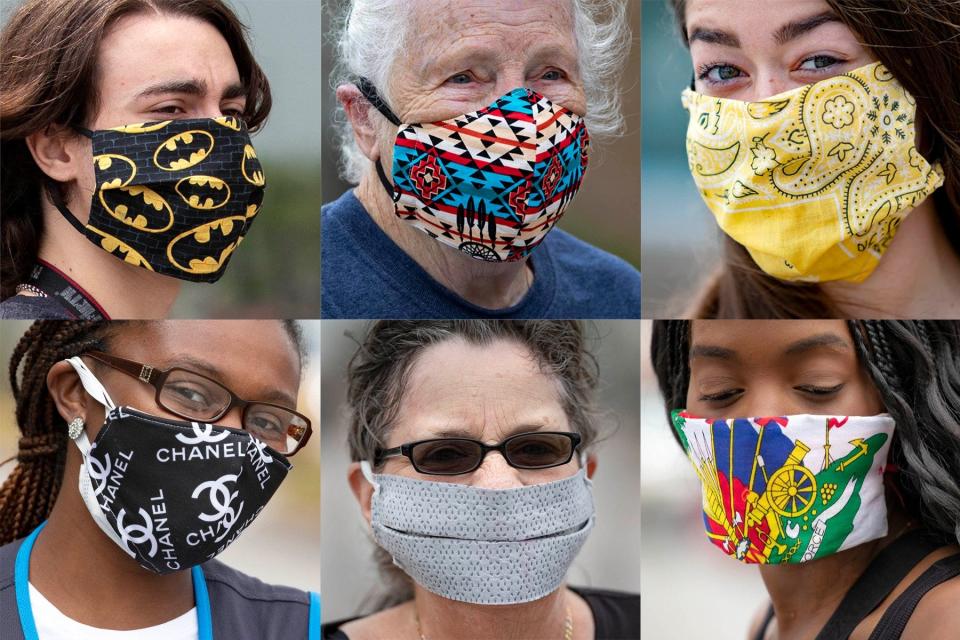COVID comeback: Much of Florida at high risk of straining hospitals; indoor masks urged
- Oops!Something went wrong.Please try again later.
The latest wave of COVID-19 infections, driven by omicron subvariants of the coronavirus, has surged so much that the U.S. Centers for Disease Control and Prevention recommends that people in most of central and southern Florida should mask up while indoors.
The CDC's "COVID-19 Community Levels" system says the disease has a high risk of straining hospitals in much of Florida, including its east coast south of St. Johns County; Alachua County; counties along Interstate 4; and the parts of Interstate 75 stretching from Tampa Bay through Sarasota County.
In these counties, infection tallies have soared past 200 cases for every 100,000 residents in the past week. Over that same time period, COVID hospitalizations have risen past 10 per 100,000 in the same period, meaning at least 10% of hospital beds are occupied by patients who tested positive.
Two weeks ago, only the South Florida counties of Palm Beach, Broward and Miami-Dade were categorized as high-risk. The CDC recommends indoor masking only in high-risk counties.

Florida's COVID deaths: Most COVID deaths in Florida came after the vaccine was widely available. Why?
Stranded overseas by COVID-19: Florida couple stranded overseas after contracting COVID during vacation
Is a summer surge coming? Deborah Birx in West Palm Beach warns of big summer COVID surge in Florida
Florida health officials logged an average of 69,329 new cases weekly since May 20, the last time the state published its COVID-19 report. That's the biggest weekly caseload increase since Feb. 11.
The state Health Department has documented almost 6.2 million infections since the start of the pandemic. Seven-day sums have grown since late March, fueled by subvariants of the omicron variant.
COVID testing results getting better
COVID tests showed some glimmer of hope.
About 16.2% of tests statewide came back positive in the past week, state health officials reported Friday. That's 2.8 percentage points higher than two weeks ago, on May 20. On that date, the positivity level had risen more than four points over two weeks prior.
But many cases go unreported because people use at-home tests, which are not counted in official statistics. Plus, people who don't feel sick rarely get tested.
Sewage readings from across the state show no signs yet of the contagion relenting. Miami-Dade County recorded 999 viral fragments for every milliliter of wastewater, the highest level since Jan. 12, according to Boston-based Biobot Analytics, which tests samples from across the nation.
It's a similar story in sewage from the Tampa Bay area counties of Pinellas and Hillsborough, along with Orange County, which contains Orlando, and its northern neighbor, Seminole County.
Sewage readings can predict coronavirus trends about a week in advance. People who catch the virus shed it. Local wastewater facilities collect sewage samples and have them tested. The advantage of sewage testing is that it gets data from everyone, including those who are infected but don't get tested.
Medical staff in Florida's hospitals tended to about 2,377 COVID-positive patients, the U.S. Health and Human Services Department reported Friday, the highest level since Feb. 28.
But a decreasing share of adult patients lie in intensive-care units — 8.9%, the smallest share recorded. HHS counted 207 adult ICU patients.
Gov. Ron DeSantis said in January that the state Agency for Health Care Administration, which oversees hospitals statewide, would separately list patients who came to the hospital because they tested positive for COVID vs. those who tested positive while in the hospital. That has yet to happen.
Don't throw those masks out yet: COVID: CDC recommends indoor masking in two major Florida metro areas
COVID treatments, therapies available: Sarasota County COVID Therapy Coalition offers guidelines on finding therapies locally
Healthcare workers face burnout: Doctors, nurses risked their lives to battle COVID. Now they're facing a mental health crisis
The number of new COVID deaths statewide has remained flat since late April, even as infections and hospitalizations surge.
Florida's COVID-19 death toll has increased by 130 people weekly since May 20, state Health Department data shows. That's lower than the two weeks leading up to that date. Weekly fatality estimates calculated with state data have been below 200 since April 22.
Vaccines, including boosters, as well as the proliferation of COVID treatments, have helped combat the severity of the disease. Plus, the CDC estimates the virus has infected 56% to 61% of Floridians, based on a sample of 1,685 antibody test results collected from commercial labs Feb. 1-21. The special tests confirm if someone's immune system has made antibodies through coronavirus infection.
COVID-19 has killed at least 74,590 Florida residents so far. The majority of those deaths occurred after vaccines became freely available statewide, mostly because unvaccinated people chose not to get inoculated.
State health officials have counted 15,460,652 Florida residents with at least one dose of the COVID vaccine.
The Health Department has steadily subtracted some 14,000 people from its inoculation count since April 8. The reason for the unprecedented decline, Health Department Press Secretary Jeremy Redfern has said, is the state's published numbers are "preliminary."
Booster shots have gone into the arms of 5,268,033 state residents, health officials reported Friday. About 74% Floridians ages 5 and older have gotten at least one shot, a ratio unchanged since Feb. 4.
About 25% of eligible Floridians are boosted, about the same level as March 25.
Chris Persaud is The Palm Beach Post's data reporter. Email him at cpersaud@pbpost.com.
This article originally appeared on Palm Beach Post: COVID: CDC urges masks indoors in some Florida counties as cases climb

